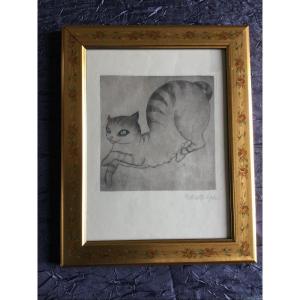.
- A little bit stained in the margins and very occasionally in the image, minimal hole above the signature, traces of creasing. At the back side's margins with remnants of an old mounting.
- Flaming Flatness -
In the context of French Japonism, the color woodblock print, which was widespread in the Asian region, was rediscovered for Western art. The artists of the time, such as Édouard Manet, Claude Monet, Edgar Degas, Paul Gauguin and Vincent van Gogh, were inspired not only by the cultural influence, but also by the two-dimensionality of the pictorial spaces. Thus, color woodcuts became an important moment in the development of the modern pictorial concept founded by Impressionism.
In Rudolf Hayder's "Herons", too, the two-dimensionality of the pictorial space is decisive for the pictorial effect. The herons, surrounded by reeds, are framed by the yellow background of the lake, followed by the dark blue-greenish stripe of the opposite shore and, above it, the sky in a lighter blue-green. Formally, it is a sequence of planes, but the two-dimensionality of the motif creates a spatial effect. This spatiality in the surface creates an intense pictorial effect. Hayder intensifies this effect with the blazing lake. In terms of color, the water becomes a sunset. The yellow turns reddish brown toward the shore, then fades to brownish red, while the shore is a watery turquoise. There is something ephemeral about this color mood, as evidenced by the masterful water reflections on the reeds and the legs of the herons.
In Japan, the heron is considered very important. It is said to be able to live over 1000 years. Therefore, it is considered a symbol of longevity. It is also said to choose only one partner in life, which makes it a symbol of fidelity.
Without directly addressing these meanings, Hayder develops a relationship between the herons. On the left, two of the birds stand with their necks stretched, while the animal opposite has its head tucked in. This creates a dialogicity that the viewer cannot decipher, which in turn is fueled by the flaming water.




































 Le Magazine de PROANTIC
Le Magazine de PROANTIC TRÉSORS Magazine
TRÉSORS Magazine Rivista Artiquariato
Rivista Artiquariato